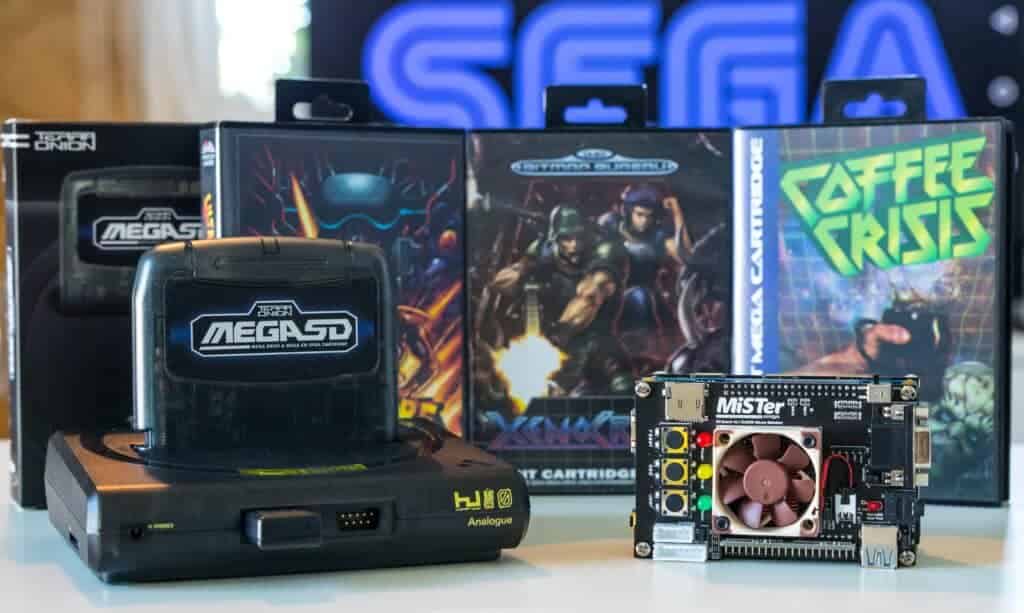The trend of retro gaming is growing in the gaming industry. It appeals to older generations with nostalgia and introduces classic games to new players. People miss the simple and charming nature of old video games, which were popular from the 1970s to the early 2000s. These classic games are regaining attention and are being played on modern gaming platforms. Vintage hardware clones and retro games are becoming more available, showing that pixel art, chiptune soundtracks, and classic gameplay still have widespread appeal. Despite advancing technology, people still love retro games, which challenges the industry to connect old and new hardware.
Sometimes it’s difficult to access original titles due to technology and legal issues. To keep retro gaming alive and available, solutions such as emulation and dedicated platforms have been developed. This not only respects gaming history but also influences the design and development of new games. Despite the industry’s focus on cutting-edge technology and storytelling, the influence of old-school gaming continues to shape modern gaming culture, reminding us of its humble beginnings.
The Most Iconic and Beloved Retro Gaming Consoles
| Console | Generation | Manufacturer | Why It’s Iconic |
|---|---|---|---|
| Nintendo Entertainment System (NES) | 3rd Generation | Nintendo | Responsible for revitalizing the video game industry in North America, features numerous legendary titles like Super Mario Bros. |
| Sega Master System | 3rd Generation | Sega | Powerful competitor to NES that brought unique experiences, like Phantasy Star, to home consoles for its time. |
| Super Nintendo Entertainment System (SNES) | 4th Generation | Nintendo | Boasted enhanced graphics and iconic games like Super Metroid & The Legend of Zelda: A Link to the Past. |
| Sega Genesis/ Mega Drive | 4th Generation | Sega | Aggressive marketing and a focus on edgier games made it a major rival to the SNES, home to hits like Sonic the Hedgehog. |
| PlayStation | 5th Generation | Sony | Its use of CDs revolutionized game storage and led to longer, more cinematic games like Final Fantasy VII. |
Important Notes:
- Honorable Mentions: Other consoles like the Atari 2600, N64, TurboGrafx-16, and more also have their dedicated fanbases.

Key Takeaways
- Retro gaming’s popularity is driven by nostalgia and the timeless appeal of classic games.
- Technological advancements facilitate access to retro games on contemporary platforms.
- Retro gaming’s legacy informs and shapes modern gaming developments.
What Is Retro Gaming
Retro gaming is a broad term encompassing the playing and collecting of older video games, consoles, and computers. Here’s a breakdown of what it means:
Critical Aspects of Retro Gaming
- Age: There’s no strict definition of what makes a game “retro,” but it generally encompasses titles and systems that are at least a few generations old. This could include anything from 8-bit and 16-bit era consoles to early computer games.
- Nostalgia: Retro gaming is often driven by nostalgia, as people seek to relive the games they enjoyed during their childhood or discover classics they missed.
- Re-releases and Emulation: Retro gaming can involve playing original cartridges on old consoles, but it also means enjoying these games through modern means like:
- Re-releases: Official re-releases of classic games on modern platforms
- Emulation: Software that recreates old hardware on current computers and devices, letting you play retro games
- Collecting: Some retro gamers are collectors seeking out original hardware, cartridges, and other memorabilia.
Why Retro Gaming is Popular
- Simpler, yet Engaging: Retro games often have a more straightforward aesthetic and gameplay but still offer great fun and challenge.
- Historical Value: These games serve as a fascinating window into gaming history.
- Community: There’s a thriving retro gaming community that loves sharing memories and knowledge.
Historical Evolution of Retro Gaming
The journey of retro gaming is a tale of technological metamorphosis from simple amusement to home entertainment staples, leaving a lasting imprint on the landscape of modern gaming through key systems and titles.
Key Factors Contributing to the Rise of Retro Gaming
| Factor | Description |
|---|---|
| Nostalgia | Gamers yearn to revisit titles they enjoyed in their youth, or discover classics they missed. |
| Accessibility | Emulators and re-releases make it easier than ever to play retro games on modern devices. |
| Limited Complexity | Retro games often feature simpler designs and mechanics compared to many modern titles, offering a different kind of challenge and charm. |
| Historical Preservation | Retro gaming fosters appreciation for the history of video games and helps preserve important cultural artifacts. |
| Online Communities | Online forums and communities facilitate the sharing of knowledge, experiences, and passion for retro gaming. |
| Collector Culture | There’s a growing market for the collection of retro games, consoles, and memorabilia. |
Important Note: These factors don’t act in isolation; they often work together to fuel the continued popularity and growth of retro gaming.
From Arcades to Home Consoles
In the late 1970s and early 1980s, arcade cabinets were the epicenters of gaming. Pioneers like “Space Invaders” and “Pac-Man” fostered social gaming environments. The transition from arcades to home gaming began with consoles like the Atari 2600, which brought the excitement of arcades into the living room.
Arcade Cabinets
- “Space Invaders” (1978)
- “Pac-Man” (1980)
Home Consoles
- Atari 2600 (1977)
Landmark Systems and Games
The Nintendo Entertainment System (NES) sparked a revolution in the mid-1980s, with captivating franchises like “Super Mario Bros.” and “The Legend of Zelda.” The gaming culture evolved further in the 90s with the SEGA Genesis and Super Nintendo Entertainment System (SNES), which introduced characters like “Sonic the Hedgehog” and advanced storytelling in games like “Metal Gear Solid.”
Notable Systems
- NES (1985)
- SEGA Genesis (1989)
- SNES (1990)
- Nintendo 64 (1996)
Influential Games
- “Super Mario Bros.” (1985)
- “The Legend of Zelda” (1986)
- “Sonic the Hedgehog” (1991)
- “Metal Gear Solid” (1998)
The Revival of Classic Titles
Nostalgia drives the resurgence of old games, with players revisiting the adventures that shaped their childhood memories. Classic consoles are being re-released or emulated, and franchises like “Mario” and “Zelda” continue to find new life on modern platforms. Innovation ensures that these classic games remain accessible and enjoyable.
- Classic Console Re-releases
- NES Classic Edition
- SNES Classic Edition
- Game Revivals
- “Super Mario Bros.”
- “The Legend of Zelda”
List Of Iconic Retro Games
A huge number of games have become iconic symbols of retrogaming, but some have stood the test of time and are very popular with modern generations of players:
Super Mario Bros. This game is synonymous with retrogaming, representing the genre with its memorable characters and innovative gameplay.
The Legend of Zelda Another classic, it revolutionized gaming with its intricate storylines, expansive worlds, and challenging puzzles.
Pac-Man This simple yet addictive game is a testament to the enduring appeal of retro games, with its straightforward gameplay and charming aesthetic.
And here’s just a few more:
Super Mario Bros. 3 (NES)
The Legend of Zelda: A Link to the Past (SNES)
Street Fighter II Turbo (Arcade)
Tetris (Gameboy)
Super Mario Kart (SNES)
Donkey Kong (Arcade)
Sonic the Hedgehog (Mega Drive and Game Gear)
Sonic the Hedgehog 2 (Mega Drive and Game Gear)
Outrun (Arcade)
Super Metroid (SNES)
Space Invaders (Arcade)
Paperboy (Arcade)
Streets of Rage 2 (Mega Drive)
Duck Hunt (NES)
Ms. Pac-Man (Atari)
Pong (Arcade)
Sensible Soccer (Amiga)
Day of the Tentacle (MS-DOS)
Manic Miner (ZX Spectrum)
Chuckie Egg (ZX Spectrum)
Street Fighter II (SNES)
Prince Of Persia (Game Gear)
Tomb Raider (Playstation)
Gran Turismo 2 (Playstation)
Metal Gear Solid (Playstation)
Tekken 3 (Playstation)
Final Fantasy VII (Playstation)
Megaman 2 (NES)
Punch-Out!! (NES)
The Legend Of Zelda (NES)
Super Mario Bros. (NES)
Retro Gaming in Modern Culture
Retro gaming has seen an upsurge in popularity, significantly influencing the entertainment industry and becoming an integral part of modern culture.
Integration with Current Trends
The gaming industry has cleverly blended retro aesthetics with modern technology. Pixel art, once a necessity due to hardware limitations, now serves as a stylistic choice in indie games like “Stardew Valley”. Emulation and digital distribution platforms like GOG and Steam have made vintage games more accessible, allowing gamers to play classic titles from systems like the NES on their contemporary devices. Miniaturized versions of classic consoles, such as the NES Classic and Sega Genesis Mini, offer a plug-and-play experience, merging the simplicity of old games with modern HDMI connectivity.
Community and Nostalgia
Nostalgia is a compelling aspect of retro gaming, leading to the formation of vibrant communities. Gamers find themselves drawn to the simpler times of gaming, comparing the straightforward fun of the past with the often more complex titles of today. Multiplayer capabilities of vintage games now often include online functions, enabling interactions beyond the traditional couch co-op. Gaming conventions and online forums serve as hotspots for fans to share their passion for collecting and discussing ROMs, emulation, and memories of past gaming experiences.
Market for Retro Games and Consoles
The market for retro games and consoles has expanded, appealing to both collectors and new players alike. The demand for original cartridges and consoles has seen a resurgence, reflected in places like online auction sites and retro gaming shops. Digital distribution platforms such as GOG.com offer an extensive library of classic titles, providing legal and convenient access to old favorites. Innovations in gaming technology, such as augmented reality, have yet to overshadow the timeless appeal of retro games, as they continue to be celebrated and played by generations both old and new.
Frequently Asked Questions
This section provides answers to common queries about the increasing appeal of retro gaming and how it maintains its significant position in the gaming industry.
What factors contribute to the popularity increase in retro gaming?
Several elements have played into the rising popularity of retro gaming. Often, the simplicity and directness of vintage games, coupled with limited hardware capabilities, led developers to focus intensely on engaging gameplay. Additionally, a shift in cultural trends has seen values placed on rediscovering and appreciating these older titles.
How has the integration of retro games into modern platforms influenced the gaming industry?
The merge of retro gaming with contemporary platforms has broadened the audience, allowing newer generations to access classic titles easily. This integration often sparks inspiration for developers, influencing current game design with elements from the past.
Why do gamers keep coming back to classic game titles?
Classic game titles offer a direct and approachable gaming experience that many find refreshing. These games provide a sense of accomplishment with clear goals and immediate rewards, which can be highly satisfying.
What role does nostalgia play in the rise of retro gaming?
Nostalgia is a significant driving force in the resurgence of retro gaming, connecting players to their memories of past experiences. This emotional connection encourages individuals to revisit games that played a meaningful part in their lives.
How are current gaming consoles accommodating the demand for retro content?
Console manufacturers are responding to the demand for retro content by offering digital libraries of classic games, designing consoles capable of playing old game cartridges, and even releasing miniaturized versions of classic consoles preloaded with iconic games.
In what ways have communities around retro gaming evolved with technology?
As technology advances, communities centered on retro gaming flourish through online forums, social media groups, and streaming platforms, where players share tips, organize events, and celebrate the rich history of gaming together. These platforms have bridged the gap between different generations of gamers and facilitated the sharing of retro gaming culture.






